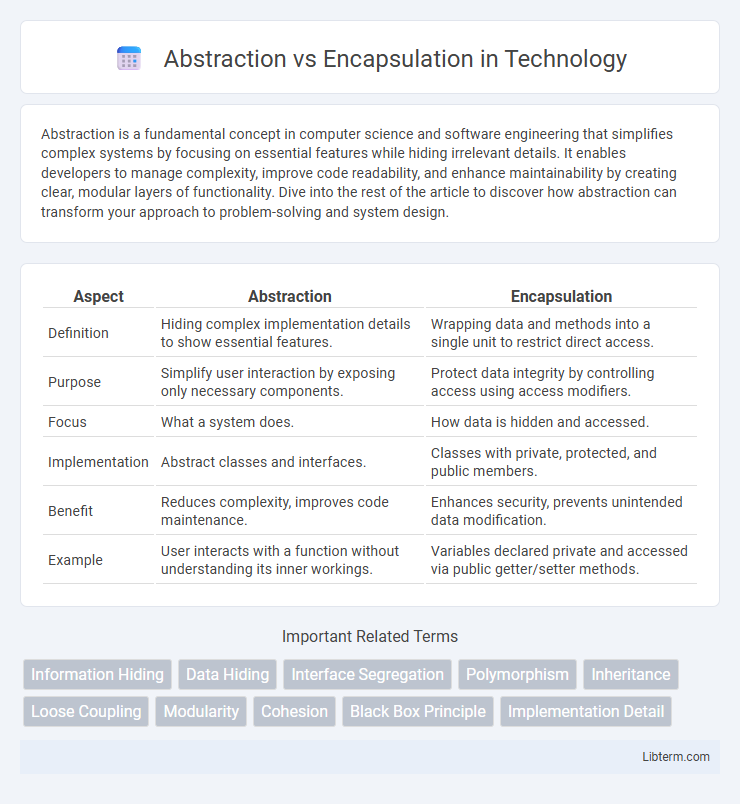Abstraction is a fundamental concept in computer science and software engineering that simplifies complex systems by focusing on essential features while hiding irrelevant details. It enables developers to manage complexity, improve code readability, and enhance maintainability by creating clear, modular layers of functionality. Dive into the rest of the article to discover how abstraction can transform your approach to problem-solving and system design.
Table of Comparison
| Aspect | Abstraction | Encapsulation |
|---|---|---|
| Definition | Hiding complex implementation details to show essential features. | Wrapping data and methods into a single unit to restrict direct access. |
| Purpose | Simplify user interaction by exposing only necessary components. | Protect data integrity by controlling access using access modifiers. |
| Focus | What a system does. | How data is hidden and accessed. |
| Implementation | Abstract classes and interfaces. | Classes with private, protected, and public members. |
| Benefit | Reduces complexity, improves code maintenance. | Enhances security, prevents unintended data modification. |
| Example | User interacts with a function without understanding its inner workings. | Variables declared private and accessed via public getter/setter methods. |
Understanding Abstraction and Encapsulation
Abstraction focuses on hiding complex implementation details by exposing only the necessary features of an object or system, enabling users to interact with a simplified interface. Encapsulation involves bundling data and methods within a class, restricting direct access to some of the object's components to protect the integrity of the data. Both concepts are fundamental in object-oriented programming, with abstraction emphasizing design simplicity and encapsulation ensuring controlled access and data security.
Core Differences Between Abstraction and Encapsulation
Abstraction hides complex implementation details by exposing only the essential features, while encapsulation restricts direct access to an object's data by bundling it with methods in a single unit. Abstraction is achieved through interfaces and abstract classes, emphasizing what an object does, whereas encapsulation is implemented using private and protected access modifiers to safeguard the object's internal state. Core differences include abstraction focusing on design and interface simplification, while encapsulation centers on data protection and integrity within the object's scope.
Real-World Analogies of Abstraction and Encapsulation
Abstraction can be likened to using a TV remote control, where only essential buttons are visible to perform functions without exposing the internal circuitry. Encapsulation resembles a capsule medicine, where the drug's contents are hidden inside a protective shell, controlling access and preventing direct interaction. Both concepts enhance usability and security by managing complexity and restricting interaction to necessary aspects.
How Abstraction Simplifies Complex Systems
Abstraction simplifies complex systems by hiding intricate implementation details and exposing only essential features, enabling developers to interact with high-level concepts rather than low-level code. This approach reduces cognitive load and facilitates easier maintenance, scalability, and understanding of software components. Unlike encapsulation, which focuses on restricting direct access to data, abstraction emphasizes conceptual clarity by modeling relevant behaviors and properties.
Encapsulation: Protecting Data Integrity
Encapsulation is a fundamental object-oriented programming principle that safeguards data integrity by restricting direct access to an object's internal state through private or protected access modifiers. It enables controlled interaction with the data via public getter and setter methods, preventing unauthorized modifications and maintaining consistent system behavior. By bundling data and methods that operate on the data within a single unit, encapsulation enhances security and reduces the risk of unintended interference or corruption.
Key Benefits of Using Abstraction
Abstraction enhances software design by managing complexity through hiding irrelevant details, allowing developers to focus on the essential features of objects and systems. It improves code maintainability and scalability by defining clear interfaces, enabling easier updates and integrations without affecting other components. By promoting modularity, abstraction supports better reusability and reduces development time, making applications more efficient and robust.
Advantages of Encapsulation in Software Design
Encapsulation in software design enhances code maintainability by restricting direct access to an object's internal state, promoting data integrity and reducing system complexity. It supports modularity, allowing developers to modify or upgrade internal implementations without affecting external code. This controlled access also improves security by preventing unauthorized interference and ensuring that objects manage their own state through well-defined interfaces.
Abstraction vs Encapsulation: Practical Examples
Abstraction simplifies complex systems by highlighting essential features while hiding details, such as using an interface to define methods without implementation in a vehicle control system. Encapsulation protects data by restricting access through access modifiers, like private variables accessed via public getters and setters in a banking application. Together, abstraction and encapsulation improve code modularity and security by managing complexity and controlling data exposure.
Common Misconceptions and Pitfalls
Abstraction and encapsulation are often confused, but abstraction focuses on hiding complexity by exposing only relevant details, while encapsulation hides internal state by restricting access through methods. A common misconception is treating them as interchangeable concepts, which leads to design flaws like exposing data unintentionally or overcomplicating interfaces. Pitfalls include failing to enforce encapsulation properly, resulting in fragile code, and poorly implemented abstraction that either reveals too much or abstracts too little, hindering maintainability and scalability.
Choosing the Right Approach in Object-Oriented Programming
Choosing the right approach between abstraction and encapsulation in object-oriented programming depends on the design goals: abstraction simplifies complex systems by exposing only essential features through abstract classes or interfaces, while encapsulation protects object integrity by restricting direct access to its internal state using access modifiers like private and protected. Effective software design leverages abstraction to manage complexity and enhance code maintainability, whereas encapsulation ensures data security and prevents unintended interference, making both principles crucial for robust architecture. Understanding the specific requirements of the project guides developers to balance these concepts, optimizing modularity, reusability, and security within the codebase.
Abstraction Infographic

 libterm.com
libterm.com